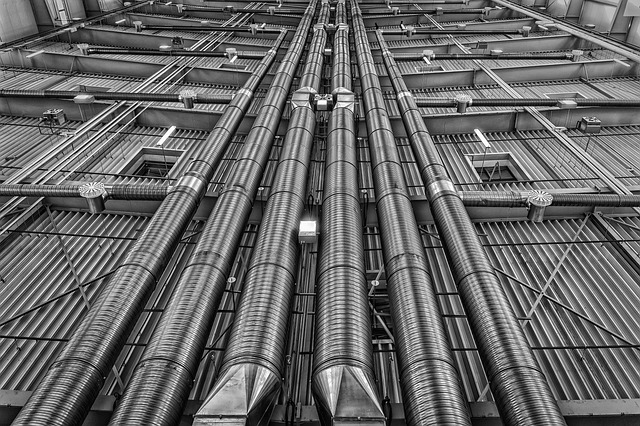Smart unit heaters revolutionize commercial and industrial heating, offering precise control and energy efficiency through integration with building automation systems. Ceiling-mounted with customizable BTU options, they provide discreet installation and optimal performance in spaces like warehouses, enhancing comfort while reducing costs via zone-specific temperature management. This technology combines forced air heating with advanced connectivity for efficient building management.
Smart unit heaters are transforming heating solutions, offering precise temperature control and energy efficiency. Integrating these devices with building automation systems (BAS) takes optimization to the next level. This article explores the benefits of combining smart unit heaters with BAS, including enhanced comfort, reduced energy consumption, and improved building management. We’ll delve into key integration components and discuss future trends that promise even greater energy efficiency for commercial and residential spaces, revolutionizing how we heat our environments.
- Understanding Smart Unit Heaters
- Benefits of Building Automation Integration
- Key Components for Seamless Integration
- Future Trends and Impact on Energy Efficiency
Understanding Smart Unit Heaters

Smart unit heaters are innovative heating solutions designed to revolutionize commercial and industrial spaces, including warehouses. These advanced devices go beyond traditional heating systems by integrating with building automation, offering precise control and energy efficiency. Unit heaters, typically ceiling-mounted, employ forced air heating mechanisms to distribute warmth evenly throughout large, open industrial spaces.
With various options available, such as gas fired units or electric heaters, each with its own BTU capacity, smart unit heaters provide a customizable solution for different applications. Their suspended design allows for discreet installation while ensuring optimal performance. This technology not only enhances comfort but also contributes to cost savings by enabling precise temperature management in specific zones of industrial spaces.
Benefits of Building Automation Integration

Integrating smart unit heaters with building automation systems offers a multitude of benefits that enhance both comfort and efficiency in various settings, from commercial buildings to industrial spaces. By seamlessly connecting with existing automation infrastructure, these advanced heaters can be centrally controlled and monitored, optimizing temperature regulation across entire facilities. This integration enables the automatic adjustment of heating based on real-time occupancy data, ensuring energy conservation without compromising comfort.
For warehouse applications and other large industrial spaces, this technology translates to significant cost savings. Gas fired units, electric heaters, and suspended heaters can be managed as a unified system, allowing for precise control of BTU capacity and forced air heating. This level of automation not only streamlines building management but also contributes to the overall sustainability of these environments, making it an ideal solution for modern commercial heating requirements.
Key Components for Seamless Integration

The key components for seamless integration of smart unit heaters into building automation systems lie in both technology and design. At the heart of this process is a gas fired unit, electric heater, or suspended heaters that are equipped with advanced connectivity features, enabling them to communicate with the central automation system. These heaters must offer precise temperature control and be capable of adjusting their output based on real-time occupancy and environmental data.
For instance, in warehouse applications and industrial spaces, forced air heating systems with variable BTU capacity can optimize energy efficiency by providing targeted heating where it’s needed most. Ceiling mounted heaters, for example, can integrate with motion sensors to activate only when an area is occupied, significantly reducing energy consumption in commercial heating scenarios. This integration not only enhances comfort but also contributes to sustainability goals by minimizing the environmental impact of heating systems.
Future Trends and Impact on Energy Efficiency

The future of unit heaters looks bright, with an increasing trend towards integration with advanced building automation systems. This evolution promises significant energy efficiency gains and enhanced comfort for both residential and commercial spaces. As technology advances, smart heaters are becoming more sophisticated, offering precise temperature control and adaptive heating patterns tailored to individual zones. This level of customization not only optimizes energy use but also reduces operational costs, especially in large industrial spaces like warehouses.
With the rise of Internet of Things (IoT) devices, unit heaters can communicate with other system components, creating a seamless network that reacts to real-time data. For instance, ceiling-mounted gas fired units or electric heaters equipped with sensors can adjust BTU capacity based on occupancy and environmental conditions, ensuring forced air heating only when necessary. This proactive approach to commercial heating has the potential to revolutionize energy management in buildings, making them more sustainable and environmentally friendly while providing optimal indoor comfort for occupants.
Smart unit heaters, when integrated with building automation systems, offer significant advantages in energy efficiency. By understanding these advanced heating solutions, leveraging their benefits, and ensuring seamless integration through key components, buildings can achieve optimal comfort while reducing operational costs. Looking ahead, these trends will continue to shape a more sustainable future for both residential and commercial spaces, making smart unit heaters an essential part of modern building infrastructure.
